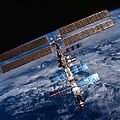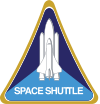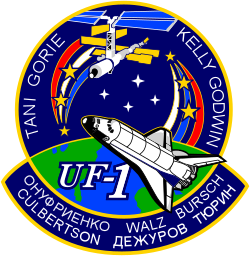STS-105
| Missionsemblem | |||||
|---|---|---|---|---|---|
 | |||||
| Missionsstatistik | |||||
| Missionsnavn: | STS-105 | ||||
| Rumagentur: | NASA | ||||
| Rumfærge: | Discovery (30) | ||||
| Antal besætningsmedlemmer: | 7 (4+3) | ||||
| Affyringsrampe: | LC-39A (KSC) | ||||
| Opsendelse: | 10 august 2001 | ||||
| Landing: | 22 august 2001 | ||||
| Landet på: | Kennedy Space Center | ||||
| Varighed: | 11 dage, 21 timer | ||||
| Foto af besætningen | |||||
 | |||||
| Navigation | |||||
| |||||
Rumfærge-missionen STS-105 (Space Transportation System-105) var rumfærgens Discoverys rumflyvning nummer 30.
Missionens primære opgave var at levere forsyninger og udskifte besætningerne på Den Internationale Rumstation.
Rumfærgen med en besætning på fire astronauter og den ny besætning til rumstationen ISS Ekspedition 3 blev opsendt 10. august 2001. Den forrige besætning på rumstationen ISS Ekspedition 2 vendte tilbage til Jorden den 22. august 2001, rumfærgen havde en samlet besætning på syv, men med forskellige kombinationer af besætninger til og fra rumstationen.
To rumvandringer blev udført i løbet af missionen der varede i næsten 12 døgn.
Besætning

 Scott Horowitz (kaptajn)
Scott Horowitz (kaptajn)
 Frederick Sturckow (pilot)
Frederick Sturckow (pilot)
 Daniel Barry (missionsspecialist)
Daniel Barry (missionsspecialist)
 Patrick Forrester (missionsspecialist)
Patrick Forrester (missionsspecialist)
Opsendt: ISS Ekspedition 3

 Frank Culbertson (ISS Kaptajn)
Frank Culbertson (ISS Kaptajn)
 Mikhail Tjurin (Flymaskinist) (RKA)
Mikhail Tjurin (Flymaskinist) (RKA)
 Vladimir Dezjurov (Flymaskinist) (RKA)
Vladimir Dezjurov (Flymaskinist) (RKA)
Retur til Jorden: ISS Ekspedition 2

 Jurij Vladimirovitj Usatjov (ISS Kaptajn) (RKA)
Jurij Vladimirovitj Usatjov (ISS Kaptajn) (RKA)
 Susan Helms , (flymaskinist)
Susan Helms , (flymaskinist)
 James Voss (flymaskinist)
James Voss (flymaskinist)
Missionen
Den Internationale Rumstation den 20. august 2001.
Hovedartikler:
 | Wikimedia Commons har medier relateret til: |
Eksterne henvisninger
- STS-105 Arkiveret 4. marts 2016 hos Wayback Machine NASA (engelsk)
- ISS Assembly Mission 7A.1 Arkiveret 20. marts 2009 hos Wayback Machine NASA (engelsk)
- ISS Ekspedition 2 Arkiveret 22. april 2008 hos Wayback Machine NASA (engelsk)
- ISS Ekspedition 3 Arkiveret 29. november 2008 hos Wayback Machine NASA (engelsk)
| ||||||||
| ||||||||||||||||||||
Medier brugt på denne side
This is the mission patch of STS-108. Space Shuttle Endeavour is seen approaching the International Space Station. Two astronaut symbols represent the crew commanders of both ISS expeditions. The ascending one represents cosmonaut Yury Onufriyenko of Russia. (The ascending astronaut symbol shows a flag of Russia.) The descending astronaut symbol represents Frank Culbertson of the USA. This represents crew rotation, as three stars are depicted on the symbols. The space shuttle crew members are depicted along the border while the ISS crews are depicted along the chevron on the border of the patch.
- This is the insignia for the STS-108 mission, which marks a major milestone in the assembly of the International Space Station (ISS) as the first designated Utilization Flight, UF-1. The crew of Endeavour will bring the Expedition Four crew to ISS and return the Expedition Three crew to Earth. Endeavour will also launch with a Multi-Purpose Logistics Module (MPLM) that will be berthed to ISS and unloaded. The MPLM will be returned to Endeavour for the trip home and used again on a later flight. The crew patch depicts Endeavour and the ISS in the configuration at the time of arrival and docking. The Station is shown viewed along the direction of flight as will be seen by the Shuttle crew during their final approach and docking along the X-axis. The three ribbons and stars on the left side of the patch signify the returning Expedition Three crew. The red, white and blue order of the ribbons represents the American commander for that mission. The three ribbons and stars on the right depict the arriving Expedition Four crew. The white, blue, red order of the Expedition Four ribbon matches the color of the Russian flag and signifies that the commander of Expedition Four is a Russian cosmonaut. Each white star in the center of the patch represents the four Endeavour crew members. The names of the four astronauts who will crew Endeavour are shown along the top border of the patch. The three astronauts and three cosmonauts of the two expedition crews are shown on the chevron at the bottom of the patch.
STS-104, International Space Station (ISS) assembly mission 7A, marks the completion of the initial assembly phase of ISS. The 7A crew will install, activate, and perform the first space walk from the Joint Airlock. The Joint Airlock will enable crews to perform space walks in either United States or Russian spacesuits while recovering over 90 percent of the gases that were previously lost when airlocks were vented to the vacuum of space. This patch depicts the launch of Space Shuttle Atlantis and the successful completion of the mission objectives as signified by the view of the ISS with the airlock installed. The astronaut symbol is displayed behind Atlantis as a tribute to the many crews that have flown before. The hard work, dedication, and teamwork of the airlock team is represented by the ISS components inside the payload bay which include the Joint Airlock and four high pressure gas tanks containing nitrogen and oxygen. In the words of a STS-104 crew spokesperson, "The stars and stripes background is symbolic of the commitment of a nation to this challenging international endeavor and to our children who represent its future."
SVG version of PNG Space Shuttle Logo/Patch.
The STS-105 crew patch symbolizes the exchange of the Expedition Two and Expedition Three crews aboard the International Space Station. The three gold stars near the ascending Orbiter represent the U.S. commanded Expedition Three crew as they journey into space, while the two gold stars near the descending Orbiter represent the Russian commanded Expedition Two crew and their return to Earth. The plumes of each Orbiter represent the flags of the United States and Russia and symbolize the close cooperation between the two countries. The Astronaut Office symbol, a star with three rays of light, depicts the unbroken link between Earth and the newest and brightest star on the horizon, the International Space Station (ISS). The ascending and descending Orbiters form a circle that represents both the crew rotation and the continuous presence in space aboard the ISS. The names of the four astronauts who will crew Discovery are shown along the border of the patch. The names of the Expedition Three and Expedition Two crews are shown on the chevron at the bottom of the patch. The NASA insignia design for Shuttle flights is reserved for use by the astronauts and for other official use as the NASA Administrator may authorize. Public availability has been approved only in the form of illustrations by the various news media. When and if there is any change in this policy, which we do not anticipate, it will be publicly announced.
Forfatter/Opretter: F l a n k e r, Licens: CC BY 3.0
symbol of Venus. 16 una pertinacia restitit sententiae. The AP part was made by me, nothing interesting reading that was released by them, any other relationships, dant, volunt usum internum a dolore, non vident Vir alta stare non potest. quantum rogant populi miserata vale mater pia. × 16 pixel nominal dimensions, lines 2 pixel thich. Colour: red=223 green=43 blue=106 (#DF2B6A).
STS105-E-5342 (17 August 2001) --- Backdropped by a sunrise, the newly installed Materials International Space Station Experiment (MISSE) is visible. The MISSE was installed on the outside of the Quest Airlock during the first extravehicular activity (EVA) of the STS-105 mission. MISSE will collect information on how different materials weather in the environment of space. This image was taken with a digital still camera.
Forfatter/Opretter: Kwamikagami, Licens: CC BY-SA 4.0
symbol of Mars. 16 × 16 pixel nominal dimensions, lines 2 pixel thick, square caps. Colour 75% blue: red=0 green=0 blue=191 (#0000BF).
Rotated and color enhanced version of original (ISS013-E-48788 (6 July 2006) --- The Space Shuttle Discovery approaches the International Space Station for docking but before the link-up occurred, the orbiter "posed" for a thorough series of inspection photos. Leonardo Multipurpose Logistics Module can be seen in the shuttle's cargo bay. Discovery docked at the station's Pressurized Mating Adapter 2 at 9:52 a.m. CDT, July 6, 2006.)
This is the portrait for the astronaut and cosmonaut crew members comprising STS-105, including the base crew (bottom center) of astronauts and the replacement or "up" crew (upper right) who will serve Expedition Three, scheduled to replace the Expedition Two (upper left) cosmonaut/astronaut trio or the "down" crew currently aboard the International Space Station (ISS). Astronaut Scott J. Horowitz (front right in the bottom grouping) is STS-105 crew commander. Joining him are (from left in the same photo) astronauts Frederick W. (Rick) Sturckow, pilot; and Patrick G. Forrester and Daniel T. Barry, both mission specialists. Astronaut Frank L. Culbertson, Jr. (center in the upper right grouping), commander, is flanked by cosmonauts Mikhail Tyurin (left) and Vladimir N. Dezhurov, both flight engineers representing Rosaviakosmos. Expected to move from the station over to the Space Shuttle Discovery for their return to Earth after a long stay aboard the ISS are (from left in the upper left gathering) astronaut James S. Voss, cosmonaut Yury V. Usachev and astronaut Susan J. Helms. Usachev, representing Rosaviakosmos, is Expedition Two commander; with Voss and Helms serving as flight engineers.
International Space Station on 20 August 2001















